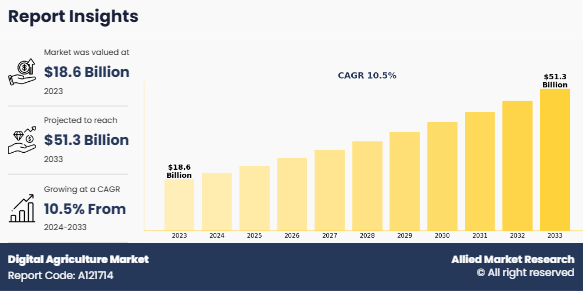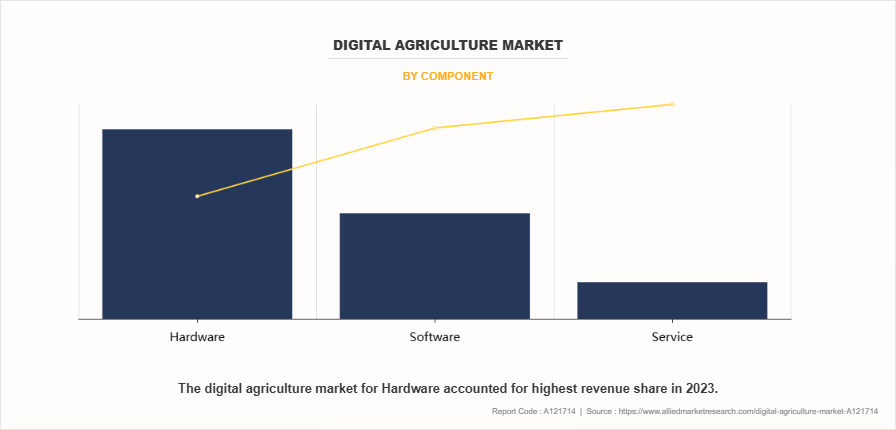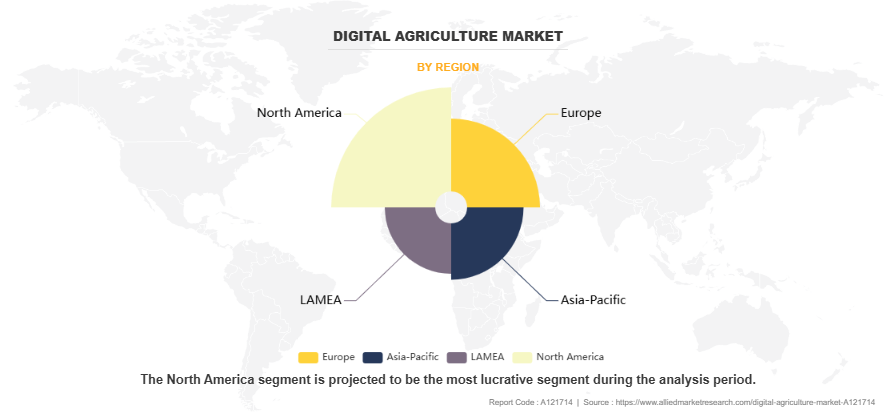Digital Agriculture Market Overview
The global digital agriculture market size was valued at $18.6 billion in 2023, and is projected to reach $51.3 billion by 2033, growing at a CAGR of 10.5% from 2024 to 2033.
The market is driven by increasing adoption of precision farming technologies, IoT-enabled smart farming solutions, and AI-driven analytics for crop monitoring and yield optimization. Rising demand for food security, government initiatives supporting agri-tech adoption, and the need for sustainable farming practices further accelerate market expansion.

The digital agriculture market refers to the integration of advanced digital technologies into agricultural practices to enhance productivity, sustainability, and efficiency. The digital farming market encompasses solutions such as precision farming, IoT-based farm monitoring, AI-driven analytics, automation, and blockchain for supply chain transparency. Digital agriculture enables farmers and agribusinesses to optimize resource usage, reduce environmental impact, and improve crop yields by leveraging real-time data and predictive analytics. Governments, corporations, and agricultural technology firms are investing in digital agriculture to address global food security challenges, climate change concerns, and the increasing demand for sustainable farming solutions. The adoption of digital agriculture is fueled by the growing need to minimize water usage, optimize fertilizers and pesticides, and enhance supply chain efficiency through traceability and automation.
Additionally, digital agriculture technologies support precision livestock monitoring, financial management for farmers, and smart irrigation systems, ensuring optimal farm operations. The growth of the digital agriculture industry is driven by rising investments in agri-tech startups, government initiatives promoting smart farming, and the adoption of cloud-based farm management solutions. Farmers and agribusinesses benefit from digital agriculture by improving yield forecasting, reducing input costs, and ensuring compliance with evolving agricultural regulations. Despite rapid advancements, challenges such as high implementation costs, limited digital infrastructure in rural areas, and concerns about data security remain key barriers to widespread adoption.
However, these challenges are being addressed through government subsidies, public-private partnerships, and technological innovations aimed at making digital agriculture more accessible and cost-effective. As the agriculture sector embraces digital transformation, the digital agriculture industry is expected to grow significantly, playing a crucial role in ensuring sustainable food production and environmental conservation. By combining traditional farming practices with cutting-edge technology, digital agriculture is set to revolutionize the global agricultural landscape, helping farmers maximize efficiency while minimizing environmental impact.
Segment Review
The digital agriculture market is segmented on the basis of component, application, technology, and region. By component, the market is divided into hardware, software, and service. In terms of application, the market is segregated into precision farming & farm management, livestock monitoring, supply chain, financial management, and others. By technology, the digital farming market is categorized into AI, drones, IoT, automation, and others. On the basis of region, it is analyzed across North America, Europe, Asia-Pacific, and LAMEA.

On the basis of component, the hardware segment dominated the digital agriculture market size in 2023, driven by the widespread adoption of precision farming equipment, IoT-enabled sensors, GPS devices, drones, and automated machinery. The increasing demand for real-time farm monitoring, yield optimization, and automated irrigation systems contributed to the dominance of the hardware segment. The integration of AI-powered agricultural robots, autonomous tractors, and smart greenhouses further strengthened the hardware segment’s market size.
However, the services segment is expected to witness the highest growth in the upcoming years, owing to the rising need for data-driven decision-making, predictive analytics, and advisory services that help farmers optimize production and resource utilization. The growing reliance on cloud-based farm management solutions, AI-driven crop monitoring, and remote sensing technologies is accelerating the demand for digital agriculture services. Additionally, the increasing adoption of subscription-based precision farming services, training programs, and technical support solutions is expected to drive the segment’s expansion.

On the basis of region, North America attained the highest digital agriculture market size in 2023, owing to the widespread adoption of advanced agricultural technologies, strong government support for precision farming, and a well-established digital infrastructure. The region’s large-scale farms, high investment in R&D, and presence of major agritech companies have further fueled digital agriculture market growth.
Additionally, the increasing use of AI, IoT, and big data analytics in farming operations, along with the rising demand for food security and sustainable farming practices, has driven the expansion of the digital agriculture market share in North America. However, Asia-Pacific is projected to be the fastest-growing region for the digital farming market during the forecast period, owing to the rising population, increasing food demand, and government initiatives promoting smart farming practices. The region’s agricultural sector is witnessing a shift toward technology-driven solutions, including AI-powered crop monitoring, drone-based pesticide spraying, and IoT-enabled irrigation systems.
The report focuses on growth prospects, restraints, and digital agriculture market trends. The study provides Porter’s five forces analysis to understand the impact of various factors, such as bargaining power of suppliers, competitive intensity of competitors, threat of new entrants, threat of substitutes, and bargaining power of buyers, on the digital agriculture market insights.
Key Players
The report analyzes profiles of key players operating in the digital agriculture market such as John Deere, Trimble Inc., AGCO Corporation, Bayer AG, Indigo Ag, Agreena ApS, ecoRobotix SA, IBM Corporation, Microsoft Corporation, Gamaya, AgEagle Aerial Systems Inc., CNH Industrial N.V., TOPCON CORPORATION, BASF Digital Farming GmbH, Digital Agriculture Services Pty Ltd, Bosch Global Software Technologies Pvt Ltd., Wipro, Yara International ASA, AGRIVI Ltd., and Small Robot Company. These players have adopted various strategies to increase their market penetration and strengthen their position in the digital agriculture market forecast.
Digital Agriculture's Impact on World Hunger
Digital agriculture has emerged as a transformative force in addressing global hunger by enhancing food production, improving supply chain efficiency, and promoting sustainable farming practices. With the global population projected to reach 9.7 billion by 2050, the demand for food is expected to rise significantly. Digital tools such as IoT-enabled sensors, AI-driven analytics, and satellite imaging enable farmers to monitor crop health, optimize resource use, and predict weather patterns, leading to higher yields and reduced crop losses. By empowering farmers with real-time data and precision agriculture techniques, digital agriculture helps bridge the gap between food supply and demand, particularly in regions facing food insecurity.
One of the most significant contributions of digital agriculture is its ability to empower smallholder farmers, who produce nearly 80% of the food in developing countries. Mobile-based applications and affordable IoT devices provide these farmers with access to critical information on market prices, weather forecasts, and best farming practices. For instance, platforms like FarmBeats and Digital Green leverage AI and data analytics to deliver personalized recommendations, helping farmers increase productivity and income. Additionally, blockchain technology is improving supply chain transparency, reducing food waste, and ensuring fair prices for farmers. By equipping smallholders with digital tools, agriculture technology is playing a pivotal role in alleviating poverty and hunger in rural communities.
Despite its potential, the widespread adoption of digital agriculture faces challenges such as high costs, limited digital literacy, and inadequate infrastructure in developing regions. However, initiatives by governments, NGOs, and private companies are addressing these barriers. For example, the World Bank and FAO are funding projects to bring digital farming solutions to low-income countries, while agritech startups are developing low-cost, scalable technologies. As these efforts gain momentum, digital agriculture is set to become a cornerstone of global food security strategies. By increasing agricultural efficiency, reducing environmental impact, and empowering farmers, digital agriculture offers a sustainable solution to combat world hunger and ensure a food-secure future for all.
Key Benefits For Stakeholders
This report provides a quantitative analysis of the market segments, current trends, estimations, and dynamics of the digital agriculture market analysis from 2023 to 2033 to identify the prevailing digital agriculture market opportunities.
The market research is offered along with information related to key drivers, restraints, and opportunities.
Porter's five forces analysis highlights the potency of buyers and suppliers to enable stakeholders make profit-oriented business decisions and strengthen their supplier-buyer network.
In-depth analysis of the digital agriculture market segmentation assists to determine the prevailing market opportunities.
Major countries in each region are mapped according to their revenue contribution to the global market.
Market player positioning facilitates benchmarking and provides a clear understanding of the present position of the market players.
The report includes the analysis of the regional as well as global digital agriculture market trends, key players, market segments, application areas, and market growth strategies.
Digital Agriculture Market Report Highlights
| Aspects | Details |
| Market Size By 2033 | USD 51.3 billion |
| Growth Rate | CAGR of 10.5% |
| Forecast period | 2023 - 2033 |
| Report Pages | 389 |
| By Component |
|
| By Application |
|
| By Technology |
|
| By Region |
|
| Key Market Players | John Deere, YARA International ASA, AGRIVI Ltd., Bayer AG, ecoRobotix SA, Microsoft Corporation, Agreena ApS, TOPCON CORPORATION, Bosch Global Software Technologies Pvt Ltd., Trimble Inc., IBM Corporation, AgEagle Aerial Systems Inc., Small Robot Company, Digital Agriculture Services Pty Ltd, AGCO Corporation., Gamaya, Indigo Ag, Wipro Limited, BASF, CNH Industrial N.V. |
Analyst Review
The digital agriculture market has emerged as a crucial segment within the agricultural technology industry, offering innovative solutions to enhance productivity, sustainability, and resource efficiency in farming. This market is expanding rapidly as farmers, agribusinesses, and governments increasingly adopt digital tools to optimize agricultural operations. Digital agriculture leverages technologies such as artificial intelligence (AI), the Internet of Things (IoT), drones, automation, and blockchain to improve farm management, enhance crop yields, and reduce environmental impact. The adoption of digital agriculture is driven by growing food demand, climate change concerns, and the need for precision farming solutions that maximize resource efficiency. By integrating advanced analytics and automation, digital agriculture enables real-time monitoring of soil health, weather patterns, crop growth, and supply chain logistics, helping farmers make data-driven decisions.
The demand for digital agriculture solutions is further accelerated by global food security initiatives, sustainability regulations, and corporate commitments to reducing carbon footprints in food production. Digital agriculture not only enhances operational efficiency but also supports sustainable farming practices through precision irrigation, automated pest control, and smart resource allocation. Key players in the digital agriculture market differentiate themselves by offering AI-powered decision-making tools, cloud-based farm management platforms, and blockchain-enabled traceability systems. Features such as real-time data analytics, remote sensing technologies, and predictive modeling are essential for improving agricultural efficiency and meeting global food production challenges. Despite the market's strong growth trajectory, challenges remain, including the digital divide in rural areas, high implementation costs, and data security concerns. However, these challenges are being addressed through government subsidies, public-private partnerships, and investments in rural digital infrastructure.
As global agricultural systems undergo digital transformation, the digital agriculture market is expected to grow steadily, playing a critical role in ensuring food security and sustainability. By bridging the gap between traditional farming practices and cutting-edge technology, digital agriculture is reshaping the future of food production and driving innovation in the agricultural sector.
Some key players profiled in the report include John Deere, Trimble Inc., AGCO Corporation, Bayer AG, Indigo Ag, Agreena ApS, ecoRobotix SA, IBM Corporation, Microsoft Corporation, Gamaya, AgEagle Aerial Systems Inc., CNH Industrial N.V., TOPCON CORPORATION, BASF Digital Farming GmbH, Digital Agriculture Services Pty Ltd, Bosch Global Software Technologies Pvt Ltd., Wipro, Yara International ASA, AGRIVI Ltd., and Small Robot Company. These players have adopted various strategies to increase their market penetration and strengthen their position in the digital agriculture market.
The digital agriculture Market is estimated to grow at a CAGR of 10.5% from 2024 to 2033.
The Digital Agriculture Market is projected to reach $51.3 billion by 2033.
The Digital Agriculture Market is expected to witness notable growth including increasing demand for sustainable investment and regulatory support and policies.
The key players profiled in the report include John Deere, Trimble Inc., AGCO Corporation, Bayer AG, Indigo Ag, Agreena ApS, ecoRobotix SA, IBM Corporation, Microsoft Corporation, Gamaya, AgEagle Aerial Systems Inc., CNH Industrial N.V., TOPCON CORPORATION, BASF Digital Farming GmbH, Digital Agriculture Services Pty Ltd, Bosch Global Software Technologies Pvt Ltd., Wipro, Yara International ASA, AGRIVI Ltd., and Small Robot Company.
The key growth strategies of digital agriculture market players include expanding their product portfolios, mergers and acquisitions, agreements, geographical expansion, and collaborations.
Loading Table Of Content...
Loading Research Methodology...



